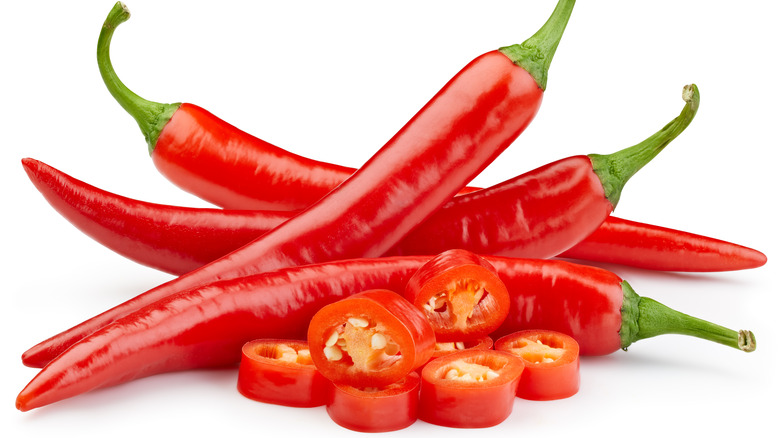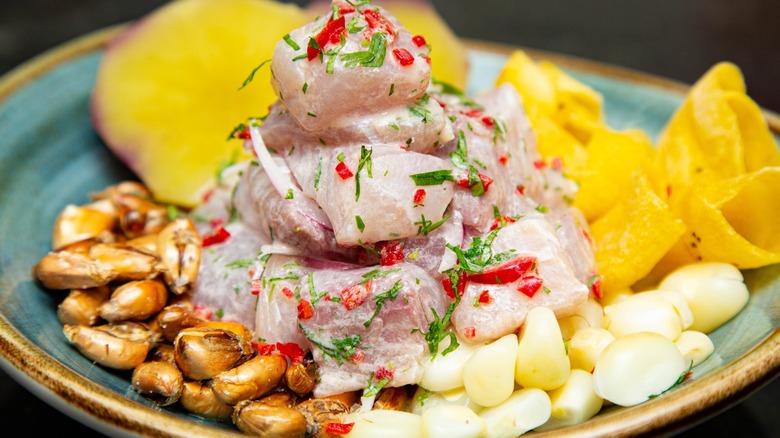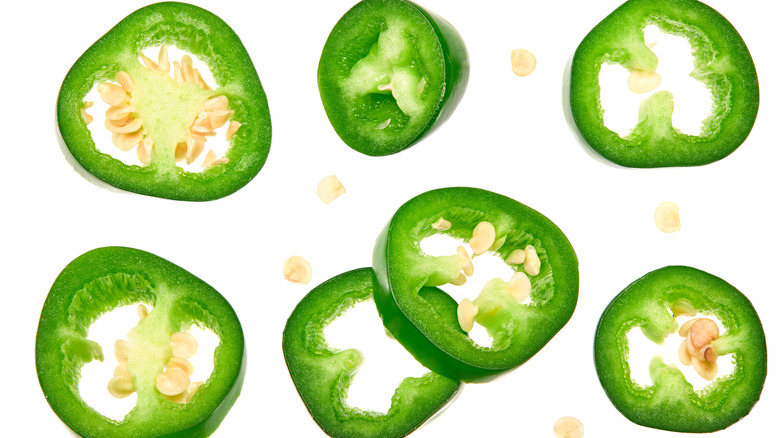The Peruvian Peppers You Can't Get Fresh In The US (But You Can Buy Frozen)
Peruvian cuisine is influenced by three geographic regions (the Pacific, Andes, and Amazon River) and results from fusions with multiple cultures and diverse populations. According to The Frederick News-Post, no less an authority than Escoffier has rated the country's food second only to France. There are Peruvian stews, soups, ceviches, sauces, and aiolis, but one thing they generally all have in common is peppers. Peppers are the backbone of Peruvian cuisine, with an estimated 300 varieties to choose from, per Frontier Co-op.
Peppers and Peru have been linked for at least 8,000 years – their use in food even predates the Incan civilization. A core group of peppers dominates Peruvian cuisine. Aji Amarillo is the most commonly used variety, and other favorites include Aji Rocoto, Aji Limo, Aji Panca, and a dried version of the Amarillo variety, Aji Mirasol. Fresh peppers are widely available in the home country, but, unfortunately, they are not generally found fresh in the United States. However, frozen peppers can be adequate substitutes, and Peruvian pepper pastes, powders, and peppers in brine are also available in the U.S. Absent finding a Peruvian grocery store, purchasing frozen peppers online is the way to go. Virtual shopping at Amazon, Food Service Direct, Goya, or Amigo Foods will yield positive results. Peppers arrive promptly, with little impact on taste, color, or heat, and can be kept in the freezer for up to a year, according to the Pepper Geek.
The DNA of Peruvian cooking
Like its relatives, Aji rocoto and limo, frozen Aji Amarillo (Aji Amarillo Congelado) is available online for less than $6 a pound. Ubiquitous in Peruvian dishes, the Aji amarillo has been nicknamed the "DNA of Peruvian cuisine," according to Specialty Produce. So prominent in the nation's food, the Amarillo variety is designated by Westland Peppers to be part of the Holy Trinity of Peruvian cuisine. Garlic and red onions complete this trio. Green at first, then turning yellow and trending toward orange as it matures, the Aji Amarillo pepper is 4-to-5 inches long. It has a fruitlike, sweet-but-spicy taste. The pepper is similar to its habanero and Scotch bonnet cousins in flavor, only packing more heat.
Combined with mayonnaise or similar ingredients, Aji Amarillo peppers form a popular aioli. The pepper is also a key component of Lomo Saltado, a signature Peruvian stir-fried beef recipe. Marinating ceviche is another common use. A dried form of the pepper known as Aji Mirasol is a mainstay of marinades, sauces, and salad dressings. It is milder than Aji Amarillo because the seeds and placenta have been removed.
Aji Amarillo contains Vitamin C and other nutrients. Like other chili peppers, it also has capsaicin, the chemical responsible for the peppers' heat. Capsaicin has many healthful properties and is used to alleviate the pain caused by arthritis and shingles, according to U.S. Pharmacist. However, the substance is also the irritant in pepper spray.
Other popular Peruvian peppers
Aji Rocoto is Aji Amarillo's hottest relative, described by PepperScale as being up to 40 times hotter than a jalapeño on the Scoville scale. It is meaty and juicy like a tomato, 2-to-3 inches long, and superficially similar in appearance to a bell pepper. With a heat level as high as 100,000 units, mistaking the Rocoto pepper for pimento can have unintended consequences. It contains characteristic black seeds and has a smoky grass-tinged taste. The pepper is the centerpiece of rocoto relleno and is a component of the restaurant staple huacatay hot sauce.
The Limo pepper variety is a colorful and fragrant one, per Specialty Produce. It gets its name from Lima, Peru's capital city, not lemons, as some may think. It isn't easy to find in the U.S. and is typically only available in frozen, dried, or paste form. Aji Panca is the least spicy member of the Peruvian pepper pantheon. It grows to 3-to-5 inches long and is dark red when ripe or chocolate-colored if sun-dried. Per Kosmos Peru, powdered Aji Panca is typically used as a spice on antichuchos, an iconic Peruvian street food. The pepper also often accompanies beef heart preparations.
These peppers are rarely, if ever, found fresh in the U.S. However, using them frozen, dried, or transformed into a paste or powder will yield authentic Peruvian flavors. Peppers that have been individually flash frozen immediately after picking will spice up any meal, Peruvian or otherwise.


